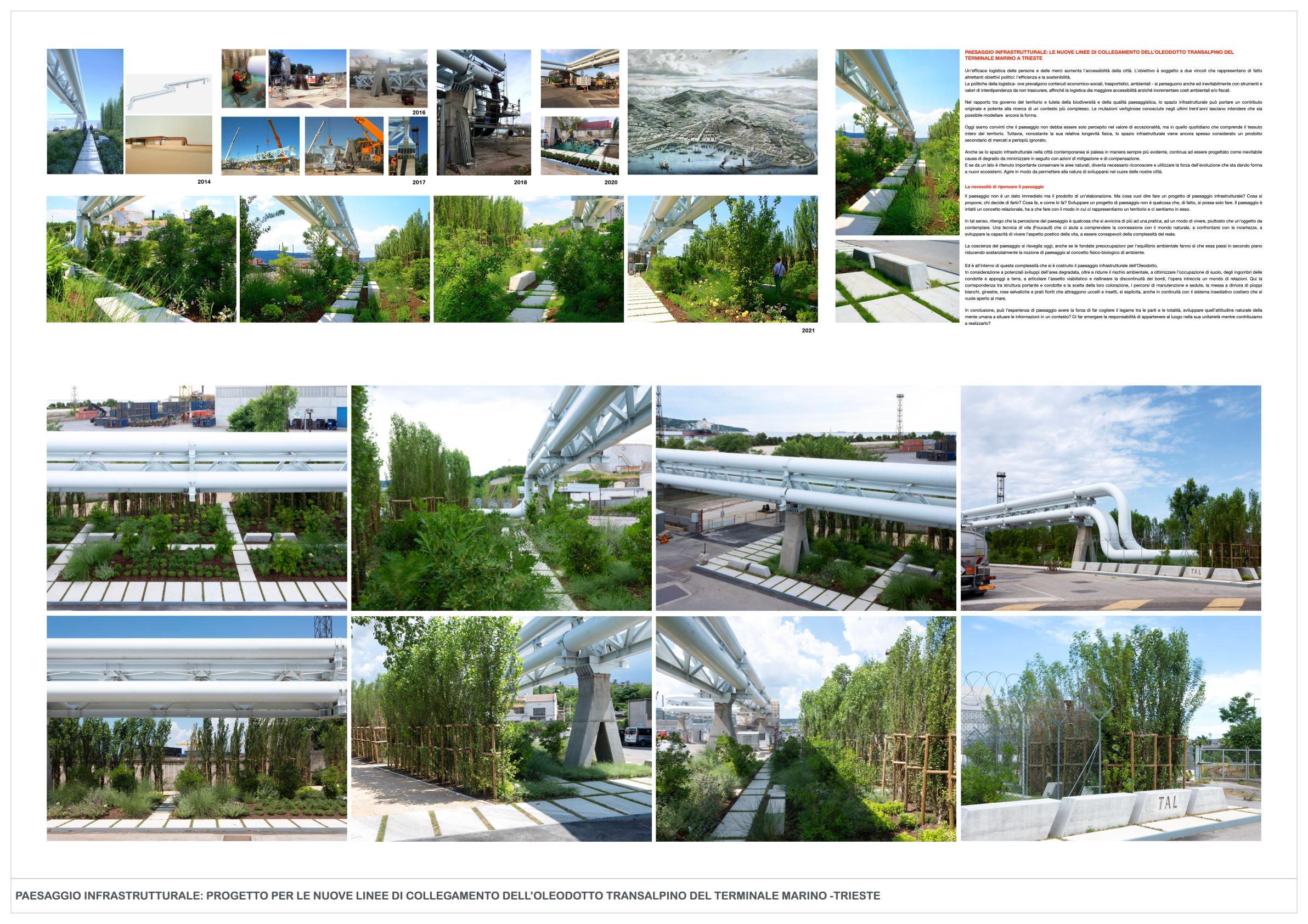Infrastructure and Landscape
Key facts
Location: Trieste, - Italy
Client: TAL OIL Group - SIOT - Società Italiana per l’Oleodotto Transalpino S.p.A
Period: 200- 2013
Project services: Landscape General projectWork progress status: Ongoing project
Project services: Head leader; coordination and landscaping
Consulents: F&M Ingegneria - Venice (geotechnics and structures); ILF Consulting Engineers Austria GmbH (pipe stress and pressure surge analysis, flexibility analysis, TL relocation); F. Messina, A. Coppola, M. Diminich, S. Forchiassin - Siot (infrastructure management)
Photography: Stefano Graziani, Erika Skabar
Work progress status: Completed
Brief description:
Situated in the Bay of Muggia in the Gulf of Trieste, the maritime terminal of the Transalpine Oil Pipeline is used for the unloading of the crude, which is then conveyed from the Port of Trieste to the Bavaria and Baden-Württemberg regions in Germany.
Tal Oil has set up a planning procedure aimed at implementing the safety of the logistical system and updating the infrastructure to the strictest safety and environmental protection standards adopted in the Oil & Gas industry and international best practices.
The application of a coherent design vision guarantees the integrated management of the various specialist activities involved (landscaping and environmental, geotechnical and structural, and pipeline system and management) and supplies a shared, efficient infrastructure solution which is able to restore a landscape of potentially even greater value than the initial level.
What do we mean when we speak of an infrastructural landscape project?
For a development, to be accessible and attractive to its users, it is essential to provide fully effective logistic system. This is because infrastructure platforms underpin how urban areas function, how they generate wealth and how they create a basis for inclusive and sustainable growth. This aim is subject to key factors which may be defined as policy objectives: efficiency and sustainability.
The logistics policies - mainly of a socioeconomic, transport and environmental nature - are of necessity pursued by means of interdependent tools and values, with a view to ensuring greater accessibility rather than increased environmental and/or tax costs.
However, despite infrastructure is expensive and has, hopefully, a long lifespan, is still often left behind as residual space/landscape. Exploring the emerging infrastructure becomes critical to recognize its role as an integral part of the system, rather than as a stand-alone element that may require "special" consideration.
Such a perspective calls for an interdisciplinary approach. The dynamic interactions between infrastructure, land management, biodiversity conservation and landscape values may become a driver in getting a more complex and therefore comprehensive inter-related context.
To reach those goals we need to make some challenging decisions about the way we use, manage, and interact with landscape.
We are more convinced than ever today that the landscape cannot be regarded as an exceptional part of our heritage, but also as an everyday phenomenon which extends to the entire territorial network. However, the cultural dimension of landscapes has been neither adequately studied nor considered “mainstream” in contemporary landscape ecology.
To move forward, we need to develop a deeper understanding of cultural landscapes, and connect culture with nature more consciously and more effectively in landscape ecological research. Wider-reaching landscape solutions should be guided by ecological, physical, social and ethical factors and most importantly, be realistic, place-specific, time-enduring and time-responsive.
The need to rethink the landscape
The creation of the landscape is not immediate, but the result of a development process, but what do we mean when we speak of an infrastructural landscape project? What are we suggesting, and who decides to go ahead with it? What does it do, and how? Developing a landscape project isn't just something that we do, as the landscape is a relations-based concept, in which the territory and our presence within it are interwoven.
In this sense, I believe the perception of the landscape is something closer to a practice or a way of living rather than something which we merely contemplate. A technique for living (Foucault) which helps us understand the connection with the natural world, take stock of our uncertainties and develop the ability to live the poetic aspect of life, in a full awareness of the complexity of the reality around us.
Our awareness of the landscape is reviving today, even though our entirely justified concerns over environmental balance take prevalence, and substantially reduce the notion of the landscape to the physical and biological concept of the environment.
It is within this complexity that the infrastructural landscape of the Oil Pipeline has been constructed.
Given the potential for development of the degraded area, the need to reduce environmental risk and optimise the way in which the land is occupied, the dimensions of the piping structures and their anchorage points, the reorganisation of the road layout and the realignment of the edges, the relations involved are many and various. All this explains the correspondence between the load-bearing structure and the piping and the colours selected, the maintenance routes and seating layouts, the planting of white poplars, broom, wild rose bushes and meadows with wild flowers to attract birds and insects, in an interweave with the coastal settlements which open out towards the sea.
In conclusion, can the landscape experience be strong enough to exploit the link between the parts and the whole and develop that natural tendency of the human mind to place the information received within a context? And to engender a sense of responsibility for belonging to the place while we contribute to making it a reality?


